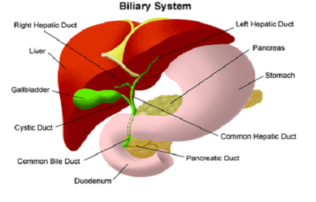Biliary Drain and Stent Insertion
Introduction
A biliary drain is used to treat a blockage in the biliary tube or ducts, which can be caused by a stone or inflammation.
This involves a drainage catheter being inserted into the blocked duct to allow bile to drain into a collection bag. This allows the liver to continue to function and reduces the chance of infection. This can also be referred to as a percutaneous biliary drain (PTC).
Once a drainage catheter is in the bile duct, it is usually possible to pass it through the blockage and into your bowel therefore draining in the normal way. This may be done as part of your initial procedure or done a few days later.
A stent is made of metal and is shaped like a tube. It is approximately 8 cm long and 1 cm wide. It may be placed in the narrowed part of your bile duct to hold it open.
The stent is permanent, but you will not be able to feel it. If you require a stent it may be done as part of your initial procedure or done a few days later.

Risks and benefits
After this procedure you should feel much better as the toxins in your blood will be lowered and the risk of infection will be reduced. It is a relatively safe procedure with smaller risks than surgery.
Occasionally we are unable to place a drainage tube in your bile duct in which case you may need to have surgery. The bile might also leak around the tube and form a collection that requires draining.
It is common to have a small amount of bleeding where the catheter is inserted. Rarely, the bleeding is more severe and a blood transfusion or an operation will be required.
The risks and benefits will be discussed with you in detail before your procedure.
Before the procedure
You must not eat or drink for 6 hours.
In the X-ray department you will be seen by a doctor who will discuss the procedure with you before you sign a consent form.
Please ask any questions you may have as it is important that you understand what is going to happen.
During the procedure
In the procedure room you will lie on an X-ray bed. Because this procedure can cause discomfort you may be given some strong pain relief through a needle put into your arm.
The doctor will use X-ray and ultrasound to determine the best position of the catheter. The skin over this area will be cleaned with antiseptic fluid and you will be covered with a sterile sheet.
The doctor will give you an injection of local anaesthetic to numb the skin. This may initially cause some stinging. Throughout the procedure a nurse will monitor you and might give you some oxygen if you need it. The doctor will insert a needle into your liver. A fine wire will then be placed through the needle and used to guide the catheter into your bile duct.
The catheter will then be fixed to your skin surface and attached to a drainage bag. We will explain what is happening throughout the procedure. The procedure usually takes about an hour but may take longer.
In some cases, a stent may be placed across the blockage to open it. If this is done, a temporary catheter may be left in place with a drainage bag attached.
After the procedure
You will go back to the ward where your nurse will monitor you as well as check the catheter regularly. You will stay in bed for a couple of hours until you have recovered. If you feel unwell at any time, please tell your nurse.
How long will the catheter stay in?
Your specialist doctor can answer this question. You will be reviewed regularly and the best treatment will be decided by your doctor depending on your condition each day.
Contact information
Chelsea and Westminster Hospital
Interventional Radiology Department
1st Floor, Lift Bank D
T: 020 3315 8570/8582

